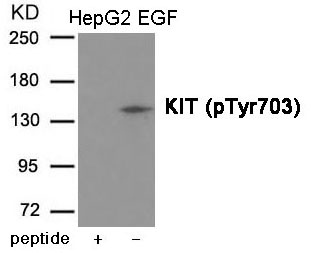Product Detail
Product NameKIT (Phospho-Tyr703) Antibody
Host SpeciesRabbit
ClonalityPolyclonal
PurificationAntibodies were produced by immunizing rabbits with synthetic phosphopeptide and KLH conjugates. Antibodies were purified by affinity-chromatography using epitope-specific phosphopeptide. Non-phospho specific antibodies were removed by chromatogramphy using non-phosphopeptide.
ApplicationsWB
Species ReactivityHu
SpecificityThe antibody detects endogenous level of KIT only when phosphorylated at Tyrosine 703.
Immunogen TypePeptide-KLH
Immunogen DescPeptide sequence around phosphorylation site of Tyrosine 703
(A-L-Y(p)-K-N) derived from Human KIT.
Target NameKIT
Other NamesPBT, SCFR, C-Kit, CD117
Accession NoSwiss-Prot#: P10721;
NCBI Gene#: 3815;
NCBI Protein#: NP_000213.1
Uniprot
P10721
Gene ID
3815;
Sdspage MW145kd
Concentration1.0mg/ml
FormulationSupplied at 1.0mg/mL in phosphate buffered saline (without Mg2+ and Ca2+), pH 7.4, 150mM NaCl, 0.02% sodium azide and 50% glycerol.
StorageStore at -20˚C/1 year
Application Details
Predicted MW: 145kd
Western blotting: 1:500~1:1000
Western blot analysis of extracts from HepG2 cells treated with EGF using KIT (Phospho-Tyr703) Antibody #12017.The lane on the left is treated with the antigen-specific peptide.
Tyrosine-protein kinase that acts as cell-surface receptor for the cytokine KITLG/SCF and plays an essential role in the regulation of cell survival and proliferation, hematopoiesis, stem cell maintenance, gametogenesis, mast cell development, migration and function, and in melanogenesis. In response to KITLG/SCF binding, KIT can activate several signaling pathways. Phosphorylates PIK3R1, PLCG1, SH2B2/APS and CBL. Activates the AKT1 signaling pathway by phosphorylation of PIK3R1, the regulatory subunit of phosphatidylinositol 3-kinase. Activated KIT also transmits signals via GRB2 and activation of RAS, RAF1 and the MAP kinases MAPK1/ERK2 and/or MAPK3/ERK1. Promotes activation of STAT family members STAT1, STAT3, STAT5A and STAT5B. Activation of PLCG1 leads to the production of the cellular signaling molecules diacylglycerol and inositol 1,4,5-trisphosphate. KIT signaling is modulated by protein phosphatases, and by rapid internalization and degradation of the receptor. Activated KIT promotes phosphorylation of the protein phosphatases PTPN6/SHP-1 and PTPRU, and of the transcription factors STAT1, STAT3, STAT5A and STAT5B. Promotes phosphorylation of PIK3R1, CBL, CRK (isoform Crk-II), LYN, MAPK1/ERK2 and/or MAPK3/ERK1, PLCG1, SRC and SHC1.
If you have published an article using product 12017, please notify us so that we can cite your literature.



 Yes
Yes



